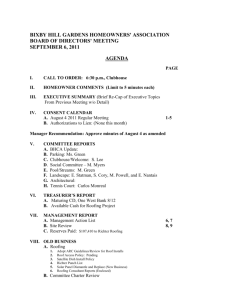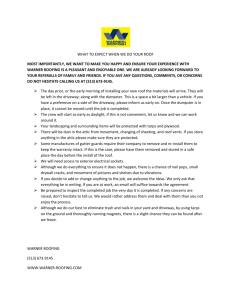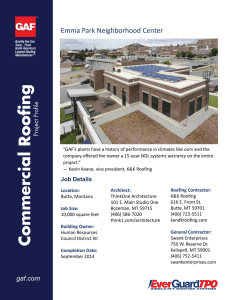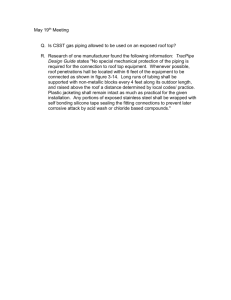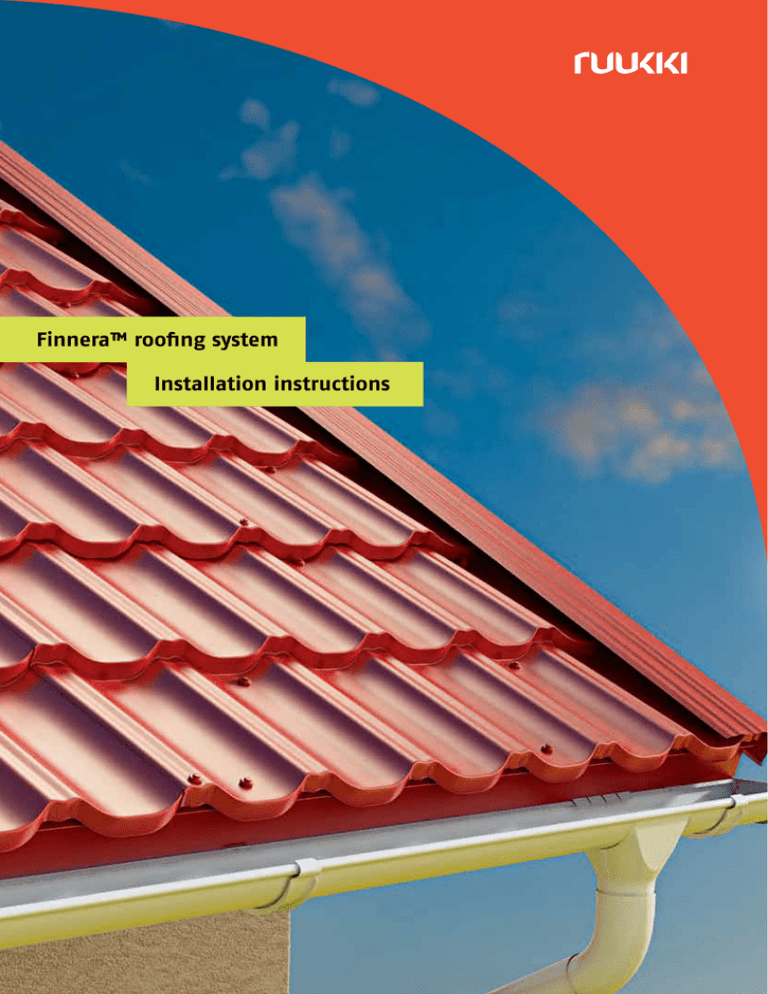
Finnera™ roofing system
Installation instructions
Finnera technical specifications
The most intelligent roof ever seen.
Finnera’s new and innovative design makes your steel roof not only
beautiful but also extremely durable and practical. The revolutionary
front-edge folding within the product maximizes weather resilience
and enables an admirable seamless roof finish, even with modular
sheet format. This means you get top quality in a fully standardized
stock-ready package, making your whole roofing project as easy and
fluent as possible. You have less to worry about, that is.
Finnera suits all kinds of roof construction needs. It is sold in installation-ready components straight from the warehouse, which
makes your roofing project easier and faster. Finnera adapts to all
roof shapes and sizes.
Designed for demanding climates.
Our roofs are designed for demanding climates and withstand years of
fluctuating conditions, from summer heat and autumn rains to icecold winter. By choosing Ruukki, the building will have a beautiful
roof that lasts for decades.
A key advantage is our unique surface treatment, i.e. the color coating. The coating gives the surface unparalleled durability, effectively
protecting it from corrosion due to humidity, and also ensures that
the color will not fade due to the sun’s UV radiation. We do not just
say this; instead we openly assign a generous product warranty for
aesthetic and functional performance.
Product
Name
e-code Total height Length of pattern
Total width Total length
Thickness Weight per piece Sales unit Finnera
TS52-330-1140
52 mm
330 mm
1190 mm
725 mm
0.50 mm
3.90 kg
pieces
Weight on roof
Area on roof
Effective width
Effective length
5.20 kg/m2
0.75 m2/pcs
1140 mm
660 mm
Material
Hot galvanized steel sheet Minimum zinc amount SFS-EN 10326
275g/m²
Coated steel flat products SFS-EN 10169-1
SFS-EN 10169-2
Finnera roofing system .......................................................... 4
Finnera technical specification ................................................ 4
Finnera roofing system components ......................................... 5
Delivery reception ................................................................ 6
Unloading and handling the delivery ....................................... 6
Dimensioning ...................................................................... 6
Work safety ......................................................................... 6
Ordering the roof ................................................................. 7
Preparing the understructure .................................................. 7
Lifting and laying out the sheets.............................................. 8
Installation method and direction ........................................... 9
Screwing ............................................................................ 9
Planning the installation ...................................................... 10
Installing the sheets............................................................. 10
Building roof valley.............................................................. 12
Flashings . ......................................................................... 14
Roof maintenance................................................................ 15
Detailed drawings ............................................................... 16
The installation methods presented in the installation instructions are for guideline purposes. The required method of
installation may vary slightly depending on the roof type or country of installation. For special instructions, updates and
more installation tips visit our web site at www.ruukkihome.com/finnera.
For general installation instructions and guidance, follow the structural designer’s instructions or contact our technical
support department.
2
Red
(RR29)
Dark brown
(RR32)
Black
(RR33)
Tolerances
Product Material 1.
2.
3.
4.
5.
6.
7.
8.
9.
10.
11.
12.
7.
EN 14782
SFS-EN 508-1
SFS-EN 10143
System components
Contents
Colours
Ridge capping flat
RA1AR
Eaves flashing
RA1BE 130
Verge trim
RA1BG
Flat sheets for special flashings
Universal filler
Screw 4,8 x 28 mm
Rainwater system
Roof bridge
Snow stops
Roof ladders
Wall ladders
Ventilation pipes
1.
4.
2.
5.
3.
6.
8.
10.
9.
3
11.
12.
Finnera roofing system
Finnera roofing system components
1.
1.
2.
3.
Finnera roofing sheet
Ridge capping flat
a. Eaves flashing 90°
b. Eaves flashing 130°
4. Verge trim
5. Universal filler
6. Screw 4,8 x 28 mm
Verge trim
Finnera roofing sheet
7.
8.
9.
10.
11.
12.
13.
2.
Screws
Eave flashing
Rainwater system
TS52-330-1140
Rainwater systems
Roof bridge
Snow stops
Roof ladders
Wall ladders
Ventilation pipes
Flat sheets for special flashings
3a.
7.
Finnera technical specifications
3b.
Product
Name
e-code Total height Length of pattern
Total width Total length
Thickness Weight per piece Sales unit Finnera™
TS52-330-1140
52 mm
330 mm
1190 mm
725 mm
0.50 mm
3.90 kg
pieces
Weight on roof
Area on roof
Effective width
Effective length
5.20 kg/m2
0.75 m2/pcs
1140 mm
660 mm
8.
4.
5.
Material
Colours
Hot galvanized steel sheet Minimum zinc amount SFS-EN 10326
275g/m²
Red
(RR29)
Coated steel flat products SFS-EN 10169-1
SFS-EN 10169-2
Dark brown
(RR32)
Tolerances
Product Material 12.
9.
6.
10.
11.
Black
(RR33)
SFS-EN 508-1
SFS-EN 10143
EN 14782
4
5
13.
Ordering the roof
Delivery reception
Ensure that the goods delivery is as ordered and features all the
goods listed on the dispatch note. Any deficiencies, errors or transport damage must be recorded in the consignment note and reported immediately to Ruukki or the retailer.
Finnera roofing comes in standard-sized pieces,
which makes the material calculation, purchasing,
transportation and installation processes easier compared to a cut-to-length system.
of
th
er
oo
fp
an
e)
Any claims regarding the delivery must be made within 8 days of
the delivery. Ruukki accepts no liability for costs arising from the
replacement of products installed in a manner other than that described in these instructions.
(le
ng
th
The number of sheets needed can be easily calculated using the three-step formula below. Alternatively, you can request your sales person to calculate
the required amount for you based on the measurements taken from your structural drawings, or
based on a simplified drawing showing the relevant
key measurements. For automatic calculator, see
www.ruukkihome.com/finnera
L
Unloading and handling the delivery
Unload the roofing sheets from the delivery vehicle onto Euro pallets
set on level ground. If Euro pallets are not available, place the sheets
onto a supporting structure covered with plywood board or a similar
level surface that is roughly equal in size to the roofing sheets.
When handling individual sheets, ensure that the sheets do not rub
against each other, ideally by hanging them from their folded edge.
Lift the sheets in stacks of three (N.B. three sheets weigh approx. 13
kg) when using scaffolds or ladders. Calculate the number of sheets
needed for the roof pane you are installing and stack the sheets in
piles on the roof pane. A hoist can also be used to lift the required
sheets up to the roof pane.
In normal conditions, the roofing sheet stacks can be stored either
packaged or unwrapped for about one month. For longer storage
periods the stacks must be protected and placed on a sloping surface
to allow any water between them to evaporate or drain off.
W (widt
h of the
roof pan
e)
Required number of Finnera pieces horizontally (X)
1. (Width - 50 mm) / 1140 mm = X pieces horizontally
(round up to the nearest whole number - use this
figure in step 3 of the formula)
Needed Finnera pieces - Example calculation:
W (width of the roof pane) = 10 000 mm
L (length of the roof pane) = 4 500 mm
Dimensioning
1. (10 000 mm - 50 mm) / 1140 mm = 8,728 = 9 pieces after rounding up
2. 4500 mm / 658 mm = 6,838 = 7 pieces after rounding up
3. 9 x 7 = 63 pieces of Finnera for the roof pane
The roofing sheets come in standard sizes. For ridges, roof valleys,
hipped roofs and lead-ins etc., the sheets need to be cut on site.
Roofing sheets can be cut with a handheld circular saw suitable for
cutting steel sheets, shears, nibbling machine, jigsaw or any other
non-heat generating cutting device. Use of an angle grinder and
cut-off disc for sheet cutting is strictly forbidden (doing so automatically voids the product warranty).
In addition to a hand-held circular saw with suitable blade and
shears or nibbling machine, you will need at least one screw gun
and a measuring tape. Protect the sheets before starting cutting work, as the sharp cuttings can damage the sheet surface.
Any debris created by drilling or cutting during installation must
be carefully brushed off. It is recommended that any scratches on
the coating and any visible cut surfaces are painted with suitable
touch-up paint.
Required number of Finnera pieces vertically (Y)
2. Length / 658 mm = Y pieces vertically
(round up to the nearest whole number - use this
figure in step 3 of the formula)
3. X x Y = Total number of Finnera pieces for the roof
pane
N.B. Extra sheet pieces may be left over due to rounding up.
Formula:
1. (Width - 50 mm) / 1140 mm = X
2. Length / 658 mm = Y
3. X x Y = Total number of Finnera pieces for the roof pane
For the required amounts of flashing and other accessories, contact your sales person. To make the calculations the sales person will need the basic measurements, primarily the ridge/eave (W) and verge (L)
lengths.
Work safety
Preparing the understructure
Always wear work gloves and protective clothing when working on
the sheets. Avoid contact with sharp cut edges and corners. Use the
folded front edge of the sheet to get a good grip.
Roofing underlay
Begin installing the underlay horizontally from the
eaves, over the roof trusses. The underlay should extend at least 200 mm beyond the wall at the eaves
and the verge. Staple the underlay onto the roof
trusses, and then finish the fixing by nailing wooden
strips, e.g. 22 x 50 mm (needed to ensure ventilation), on top of the underlay in the direction of the
roof trusses. Leave the roofing underlay hanging loose
between the roof trusses.
overlap
~150mm
Do not walk beneath raised sheets or sheet packages. Ensure that
the hoisting lines are in proper working order and suitable for the
sheets’ weight and that they are appropriately attached. Avoid
handling the sheets during high winds. Observe utmost caution
when moving and working on the roof. Use a safety rope and soft
soled footwear and observe all valid safety regulations.
Checking the roof measurements
At the ridge, install the underlay according to the installation instructions specified in the detailed drawings. In case of problems, contact the structural designer regarding the specific ridge design.
Roofing sheets are installed at right angle (90 degrees) to the eaves.
Before the installation, check how level the roof is, its cross-measure, and the straightness of the ridge and eaves. In problem situations, contact our technical support department.
wooden strip
e.g. 22 x 50mm
6
The underlay sheets should overlap by about 150 mm
at the horizontal joint. If the underlay must be extended lengthways, this must be done at the roof
trusses with a minimum overlap of 100 mm.
7
Installation method and direction
Starting from the eaves and working towards the
ridge, lay the sheets row-by-row, overlapping the
sheets alternately above and below each other
(above-below-above-below).
Battening and wooden raiser
330 mm
With a roof truss spacing of 900 or 1200 mm, 32 x 100
mm wooden battens will suffice. To verify the correct
batten thickness, contact your structural designer.
270 mm
The sheets can be laid horizontally either left-toright or right-to-left. Wherever possible, installation
should start from the eaves and proceed towards the
ridge.
When using Finnera roofing sheets, install a wooden
raiser (e.g. 22 x 50 mm) above the lowest roofing batten. Correct alignment of the raiser can be ensured,
e.g., by marking a straight line along the eaves using
a stringline.
wooden raiser
e.g. 22 x 50 mm
Begin installing the roofing sheet battens on the eave
where the roofing is to be installed first. This is important if the eaves are staggered and pattern adjustment must be taken into consideration.
wooden batten
e.g. 32 x 100 mm
Screwing
Overlap screw
The distance from the outer edge of the fascia boards
to the centre of the second batten is 270 mm. The distance between the remaining battening boards is c/c
330 mm.
Fixing the sheets
Screw the Finnera sheets to the battening at the
lowest point of the wave profile, just below the lateral raised edges of the sheet. With wooden battening, use 4.8 x 28 mm self-drilling screws.
Installation of fascia boards
elevation
~52 mm
Fixing screw
At the overlap joint, fix the sheets together with
the same self- drilling screws at the highest point
of the profile, just above the raised lateral edges of
the sheet. Then fasten an additional overlap screw in
the middle of the sheet, just above the raised lateral
edge. Alternatively, the overlap screws can be fastened at an angle through the raised lateral edge to
conceal the screw heads and achieve a more pleasant visual appearance.
With Finnera roofing sheets, the bargeboards should
be positioned level with the height of the profile
above the roofing battens. The verge trims will be fastened to the bargeboards.
Wooden raiser screw
Bargeboard top edge elevation above the roofing battens: approx. 52 mm
•
Installation - Eave flashing
Fasten the first row of sheets through eaves flashing
to the wooden raiser on the eaves.
Install the eave flashings before installing the roofing
sheets. Align the flashing with the eave line and fix
it to the first battening board with galvanised nails.
Install the eave flashing end-to-end, not overlapped.
•
The instructions for laying and fixing the sheets take
into account possible wind uplift on the sheet edges,
thermal movement, and the tightness and appearance of the sheet joints.
eave flashing
Lifting and laying out the sheets
Use the folded front edge of the sheet to get a good
grip and avoid sharp corners. Lift the sheets in stacks
of three (N.B. three sheets weigh approx. 13 kg) when
using scaffolds or ladders. Calculate the number of
sheets needed for the roof pane you are installing
and stack the sheets in piles on the roof pane. A hoist
can also be used to lift the required sheets up to the
roof pane.
N.B. Secure the sheets when piling on the roof pane.
Unsecured sheets are major work safety risk. Falling
sheets may cause serious damage.
•
•
•
•
•
•
Fixing screws (4pc/sheet)
•
•
•
•
•
•
•
•
•
•
•
•
•
•
••
•
Overlap screws (3pc/sheet)
9
•
•
•
•
Wooden raiser screws at eaves (for the first row 2pc/sheet)
8
•
•
Planning the installation
Before starting the sheet installation, calculate the
exact starting point for the first sheet using the
two-step formula below. This eliminates the need
to trim the last sheet in the row. The formula gives
the distance from the verge at which the first sheet
of the row should be installed. The last sheet at the
end of the row is then overlapped by the necessary
number of waves to achieve a correct fit. N.B. When
starting the installation, leave some free space beneath the verge trim. For automatic calculator, see
www.ruukkihome.com/finnera
Starting distance
of r
o
•
•
1. (Width - 50 mm) / 190 mm = A
(Round down to the nearest whole number - use
this figure in step 2 of the formula)
W(
wid
th
Remove the screw from the top left-hand corner and
align the sheets with the eave. The length over the
eave should be equal (approx. 40–45 mm).
of p
a
ne)
Starting distance from verge - example calculation:
W (width of the roof pane) = 10 000 mm
1. (10 000 mm - 50 mm) / 190 mm = 52,368 = 52 after rounding down
2. ((10 000 mm - 50 mm) / 190 mm - 52 ) x 95 mm = 35 mm
Start installation 35 mm distance from verge.
Fix the first sheet according to the screwing instructions (p.9).
2. ((Width - 50 mm) / 190 mm - A) x 95 mm = B
(B=Starting distance from the verge)
(N.B. Same distance also at the end of the pane)
The sheets are symmetrical and can be overlapped
above and below each other by one or more wave
pattern lengths.
•
•
•
•
Lift the other side of the second sheet up slightly and
slide the third sheet into place so that the second
sheet overlaps the third sheet by one wave pattern.
•
•
•
Fix the second overlapping edge at the top of the
wave, above the sheet’s two lateral raised edges.
•
Formula:
Continue the row installation as described (above–
below–above–below).
1. (Width - 50 mm) / 190 mm = A
2. ((Width - 50 mm) / 190 mm - A) x 95 mm = B = Starting distance
from the verge
Installing the sheets
At the end of the row, overlap the last sheet by the
number of wave patterns needed to make the verge.
If you used the starting distance formula, the distance from the last sheet to the verge is the same as
the starting distance for the first sheet at the beginning of the row.
At the side where you are starting the roofing, fasten
the first sheet in place, leaving a sufficient overhang
over the eave (approx. 40–45 mm).
•
Fix the sheet through eaves flashing onto the wooden raiser and temporarily fasten the top left-hand
corner with a single screw.
•
N.B. Install the first sheet at the starting point, i.e.
the distance from the verge determined by the starting distance formula.
Continue the installation as described (above–below–above–below) row-by-row, working upwards
from the eaves to the ridge.
Lay the second sheet alongside the first so that the
sheets overlap by one wave pattern length. Fasten
the overlapping edge of the second sheet in place
with screws at the top of the wave, just above the
two raised lateral edges of the sheet.
•
•
Brush off any cutting and drilling debris from the
finished roof pane using a soft brush. Carry out
touch-up painting as necessary.
•
•
10
11
Building roof valley
Lay the base boards for roof valleys level with the
roof pane battening. Leave ventilation gaps of approx. 20 mm between the roof valley boards.
Lay the full-size roofing sheets. Leave the sheets that
require cutting uninstalled at this stage.
Install a wooden raiser on top of the first batten and
valley boards at the eaves.
N.B. Do not fully fasten the roofing sheets along the
valley yet. Fasten the sheets fully in place only after
the cut sheets have been installed along the valley.
Cut the eave flashing to shape and install it in the
corner of the roof valley.
Measure the space for the roofing sheet. Measure
from the guide line to where the roofing sheet overlap ends.
•
X mm
Measure the widths from two points: from lowest
point of the sheet (Y) and the highest point of the
sheet (X).
>200 mm
•
Fit the angled roof valley sheet in place. Fasten the
sheet in place with galvanised nails. The angled roof
valley sheet should have an overlap of at least 200
mm at the joints. The use of sealing compound to
seal the overlap is recommended.
•
Draw the measured cutting line onto the roofing
sheet.
Y mm
Cut the sheet.
•
Cut and shape the bottom end of the roof valley
sheet according to the alignment of the eaves.
Draw guide lines on the roof valley sheet to show the
alignment of the sheets along the roof valley.
•
•
•
Install the cut roofing sheets up to the top of the roof
valley, making sure as you proceed that the angle of
the roof valley follows the drawn guide line.
•
The minimum distance between the guide lines (indicating the position of the roofing sheets) must be
at least 200 mm. The angled roof valley sheet must
extend at least 250 mm beneath the roofing sheets.
Apply universal filler to the roof valley sheet: remove
the cover tape from the universal filler and apply it
about 30 mm from the guide lines in the edge direction of the valley sheet.
•
Fix the roofing sheets installed along the roof valley
in place with self drilling screws.
•
Brush off any cutting and drilling debris from the
finished roof pane using a soft brush. Carry out
touch-up painting as necessary.
•
•
~260 mm
12
13
Flashings
Roof maintenance
Verge trim
Annual maintenance
Removal of snow
Install the verge trims from the eaves upwards. Trim
off any extra length at the ridge. Fix the trims to the
fascia boards and from above to the roofing sheets
with self-drilling screws at approx. 1000 mm screw
spacing. Overlap the verge trims by at least 100 mm.
To ensure optimal condition and a long service life, the roof condition should be inspected regularly. Under normal conditions the
surface will be kept sufficiently clean by rainfall, although any
fallen leaves, twigs etc. not washed away by rainwater should be
cleared from the roof on an annual basis. Roof valleys and rainwater systems also require annual cleaning.
Snow will not typically accumulate on the painted roof or exceed
the roof’s structural load capacity. However, if snow removal is required, a layer of snow (~100 mm) is recommended to be left on
the roof to protect the coating during snow removal.
N.B. The verge trim must extend over the first pattern profile of the roofing sheet. Use the formula to
calculate the starting distance at the beginning of
the installation.
~100 mm
Cleaning
Dirt and stains can be washed off with a soft brush and water.
Pressure washers (up to 50 bar) may also be used. More persistent
dirt can be cleaned using a detergent intended for cleaning painted
surfaces. Follow the detergent’s usage instructions or contact the
product manufacturer to verify its suitability. Persistent localised
stains can be rubbed off with a cloth dipped in white spirit. The
paint coating should be rinsed from the top down to ensure all
detergent is removed. Finally, flush the rainwater systems through
with water.
Ridge filler
Apply universal filler to the ridge capping before fixing the capping to the roof. Remove the cover tape
from the universal filler and apply the filler under
the ridge capping about 50 mm from the edge in the
ridge direction.
•
N.B. It is not recommended to fix screws through the
filler.
•
~50 mm
Ridge capping
Fix the ridge capping to the roofing sheets at every
third wave with self-drilling screws. The ridge cap
overlap must be at least 100 mm.
14
15
Detailed drawings 1/2
Detailed drawings 2/2
Ridge
Eaves
1.
1.
2.
3.
4.
5.
6.
7.
8.
2.
3.
4.
5.
6.
7.
8.
9.
10.
Roofing underlay (ventilation gap at ridge ≥ 100
mm)
Wooden strip, e.g. 22 x 50 mm
Batten, e.g. 32 x 100 mm
Roofing underlay strip, width ~400 mm
Finnera roofing sheet
Screw
Universal filler
Ridge capping flat
Screw (to every third wave)
Ventilation (if needed)
Roofing underlay
Wooden strip, e.g. 22 x 50 mm
Batten, e.g. 32 x 100 mm
Eaves flashing
Finnera roofing sheet
Screw (for Finnera)
Screw (for gutter bracket)
Wooden raiser, e.g. 22 x 50 mm
Roof valley
Verge
1.
1.
2.
3.
4.
5.
6.
7.
Roofing underlay
Batten, e.g. 32 x 100 mm
Finnera roofing sheet
Screw
Verge trim
Screw (to every ~1000 mm)
Screw (to every ~300 - 800 mm)
2.
3.
4.
5.
6.
7.
8.
Roofing underlay
(Lowest strip of underlay parallel with roof valley,
underlays from pane of roof over it overlapped)
Wooden strip, e.g. 22 x 50 mm
Roof valley boarding, e.g. 32 x 100 mm
Valley flashing
Universal filler
Finnera roofing sheet
Screw
Roof rails
Roof-to-wall intersection, end wall
Intersection, vertical detail
1.
2.
3.
4.
5.
6.
Joint flashing
Universal filler
Finnera roofing sheet
Batten, e.g. 32 x 100 mm
Screw
Roofing underlay
1.
2.
3.
4.
5.
6.
7.
Roof rail
Wooden strip, e.g. 22 x 50 mm
Batten, e.g. 32 x 100 mm
Finnera roofing sheet
Screw
Roofing underlay
Overlap screw
Battening
•
Roof-to-wall intersection, sidewall
•
1.
2.
3.
4.
5.
16
Joint flashing
Screw
Finnera roofing sheet
Roofing underlay
Batten, e.g. 32 x 100 mm
17
The distance from fascia boards outer surface to
the middle of second batten is 270 mm.
The distance between rest of the battening boards
is c/c 330 mm
Tel. +358 20 59 127 www.ruukkihome.com
Copyright © 2010 Rautaruukki Corporation. All rights reserved. Ruukki, Rautaruukki, More With Metals and Ruukki’s product
names are trademarks or registered trademarks of Rautaruukki Corporation

